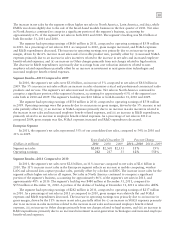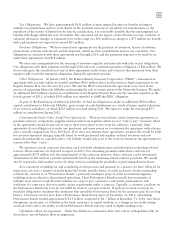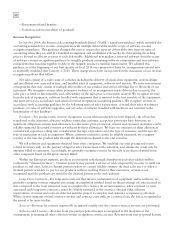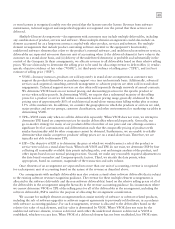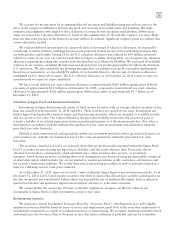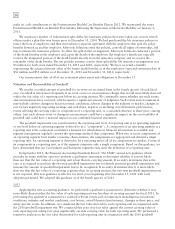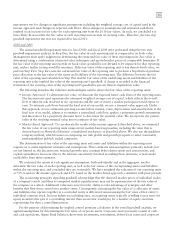Motorola 2011 Annual Report Download - page 51
Download and view the complete annual report
Please find page 51 of the 2011 Motorola annual report below. You can navigate through the pages in the report by either clicking on the pages listed below, or by using the keyword search tool below to find specific information within the annual report.
45
Tax Obligations: We have approximately $191 million of unrecognized income tax benefits relating to
multiple tax jurisdictions and tax years. Based on the potential outcome of our global tax examinations, or the
expiration of the statute of limitations for specific jurisdictions, it is reasonably possible that the unrecognized tax
benefits will change within the next 12 months. The associated net tax impact on the effective tax rate, exclusive of
valuation allowance changes, is estimated to be in the range of a $50 million tax charge to a $75 million tax benefit,
with cash payments not expected to exceed $25 million.
Purchase Obligations: We have entered into agreements for the purchase of inventory, license of software,
promotional activities and research and development, which are firm commitments and are not cancelable. Our
obligations in connection with these agreements run through 2014, and the payments expected to be made by us
under these agreements total $78 million.
We enter into arrangements for the sourcing of inventory supplies and materials with take-or-pay obligations.
Our obligations with these suppliers run through 2014 and total a minimum purchase obligation of $66 million. We
do not anticipate the cancellation of any of these agreements in the future and estimates that purchases from these
suppliers will exceed the minimum obligations during the agreement periods.
Other Obligations: In January 2011, the Pension Benefit Guaranty Corporation (“PBGC”) announced an
agreement with us under which we would contribute $100 million above and beyond our legal requirement to our
Regular Pension Plan over the next five years. We and the PBGC entered into the agreement as we were in the
process of separating Motorola Mobility and pursuing the sale of certain assets of the Networks business. We made
an additional $250 million of pension contributions to the Regular Pension Plan over the amounts required, in the
fourth quarter of 2011, of which $100 million was intended to fulfill the PBGC obligation.
As part of the distribution of Motorola Mobility, we had an obligation to make an additional $300 million
capital contribution to Motorola Mobility, upon receipt of cash distributions as a result of future capital reductions
of an overseas subsidiary, of which $225 million was paid during 2011. We expect to make the remaining $75
million in contributions during 2012.
Commitments Under Other Long-Term Agreements: We have entered into certain long-term agreements to
purchase software, components, supplies and materials from suppliers which are not “take or pay” in nature. Most
of the agreements extend for periods of one to three years (three to five years for software). Generally, these
agreements do not obligate us to make any purchases, and many permit us to terminate the agreement with advance
notice (usually ranging from 60 to 180 days). If we were to terminate these agreements, we generally would be liable
for certain termination charges, typically based on work performed and supplier on-hand inventory and raw
materials attributable to canceled orders. Our liability would only arise in the event we terminate the agreements for
reasons other than “cause.”
We outsource certain corporate functions, such as benefit administration and information technology-related
services. These contracts are expected to expire in 2013. Our remaining payments under these contracts are
approximately $279 million over the remaining life of the contracts; however, these contracts can be terminated.
Termination would result in a penalty substantially less than the remaining annual contract payments. We would
also be required to find another source for these services, including the possibility of performing them in-house.
As is customary in bidding for and completing certain projects and pursuant to a practice we have followed for
many years, we have a number of performance/bid bonds, standby letters of credit and surety bonds outstanding
(collectively, referred to as “Performance Bonds”), primarily relating to projects of the Government segment,
including projects related to discontinued operations. These Performance Bonds normally have maturities of
multiple years and are standard in the industry as a way to give customers a convenient mechanism to seek
resolution if a contractor does not satisfy certain requirements under a contract. Typically, a customer can draw on
the Performance Bond only if we do not fulfill all terms of a project contract. If such an occasion occurred, we
would be obligated to reimburse the institution that issued the Performance Bond for the amounts paid. In our long
history, it has been rare for us to have a Performance Bond drawn upon. At December 31, 2011, outstanding
Performance Bonds totaled approximately $1.1 billion, compared to $1.7 billion at December 31, 2010. Any future
disruptions, uncertainty, or volatility in the bank, insurance or capital markets, or a change in our credit ratings
could adversely affect our ability to obtain Performance Bonds and may result in higher funding costs.
Off-Balance Sheet Arrangements: Under the definition contained in Item 303(a)(4)(ii) of Regulation S-K, we
do not have any off-balance sheet arrangements.






